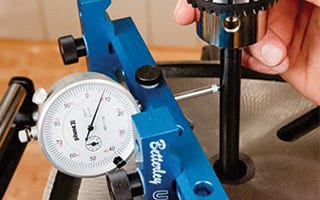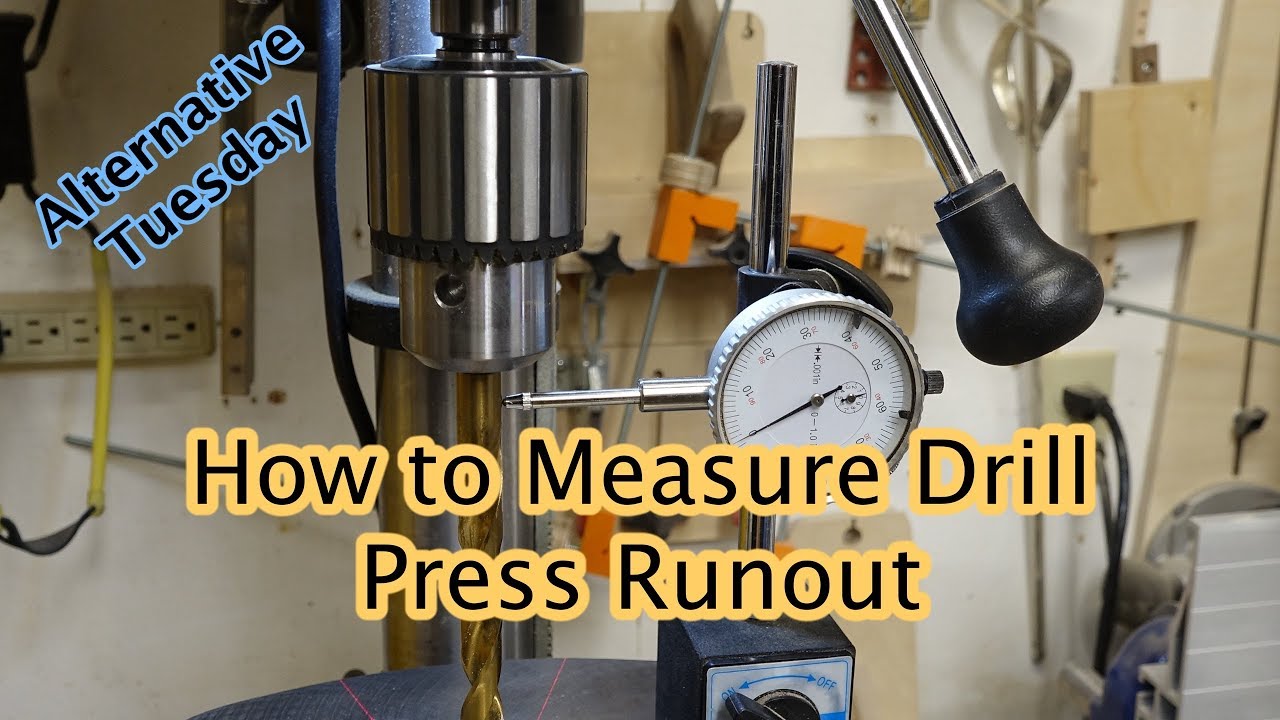Are you curious about drill press runout? Wondering what it is and why it matters? Well, you’ve come to the right place! In this article, we’ll demystify the concept of drill press runout in a simple and engaging way. So, let’s dive right in!
Imagine you’re working on a project that requires precise holes to be drilled. You set up your drill press, confident that it will do the job accurately. But wait, what’s this? The holes are slightly off-center, and the drill bit seems to wobble. That’s drill press runout for you!
Drill press runout refers to the amount of movement or deviation that occurs when the drill chuck spins the drill bit. In simpler terms, it’s the wobbling or off-center movement of the drill bit, which affects the accuracy of the holes you’re drilling. So, why does it matter? Well, let’s find out in the next paragraph!
When drill press runout is present, it can lead to several issues. Firstly, it affects the precision of your drilling. If the drill bit isn’t spinning perfectly concentrically, the holes won’t be centered or straight. This can ruin your project and cause frustration. Secondly, runout can put excessive strain on the drill bit, reducing its lifespan. Lastly, it can affect the quality of your workmanship and the overall appearance of the finished product. So, understanding and minimizing drill press runout is crucial for achieving accurate and professional results in your woodworking, metalworking, or crafting endeavors.
Drill press runout refers to the amount of wobbling or deviation in the drill bit’s rotation when it is inserted into the chuck. It can affect the accuracy and precision of your drilling. To minimize drill press runout, follow these steps:
- Start by cleaning the chuck and spindle to remove any debris.
- Securely tighten the drill bit in the chuck.
- Check the runout using a dial indicator, placing it near the drill bit.
- Adjust the chuck if necessary to reduce runout.
- Recheck the runout after adjustments.
By following these steps, you can ensure minimal drill press runout and achieve precise drilling results.

Understanding Drill Press Runout: What Every Woodworker Needs to Know
Drill press runout is a common phenomenon that can affect the precision and accuracy of drilling operations in woodworking. It refers to the amount of deviation or wobbling that occurs in the spindle of a drill press when it rotates. This runout can have a significant impact on the quality of the holes drilled, leading to misalignment and poor finishes. In this article, we will delve into the details of drill press runout, its causes, and how to minimize its effects.
Causes of Drill Press Runout
Drill press runout can be caused by various factors, both inherent to the machine and external influences. One of the primary causes is the lack of concentricity between the spindle and the chuck. This misalignment can occur due to manufacturing defects, wear and tear over time, or improper installation of the chuck. Another common cause is the presence of dirt, debris, or rust on the spindle, which can introduce irregularities and cause the drill bit to wobble.
Additionally, the quality and condition of the drill chuck can contribute to runout. A low-quality or worn-out chuck can have excessive play, leading to runout. It is also essential to consider the condition of the drill bits themselves. Dull or damaged bits can cause vibrations and increase runout. Lastly, improper feed pressure or inconsistent workpiece clamping can introduce additional forces that contribute to runout.
Impact of Drill Press Runout
Drill press runout can have several detrimental effects on the drilling process. Firstly, it compromises the accuracy and precision of the holes drilled. Even a small amount of runout can result in misaligned holes, which can be particularly problematic when drilling for dowels or joining pieces together. The wobbling motion of the drill bit can also lead to rough and uneven hole surfaces, affecting the overall finish of the workpiece.
Moreover, drill press runout can increase the likelihood of drill bit breakage. The oscillating motion of the bit puts additional stress on its cutting edges, making it more prone to snapping or chipping. This not only reduces the lifespan of the bit but also poses a safety hazard to the operator. Additionally, runout can cause excessive heat buildup during drilling, leading to burning of the workpiece or overheating the drill press motor.
Minimizing Drill Press Runout: Tips and Techniques
Fortunately, there are several measures you can take to minimize drill press runout and ensure accurate drilling results. The first step is to ensure proper maintenance of your drill press. Regularly clean the spindle and chuck to remove any dirt or debris that could contribute to runout. Inspect the chuck and spindle for wear and replace them if necessary. Lubricating the spindle can also help reduce friction and minimize runout.
Investing in a high-quality drill chuck can significantly improve the precision of your drilling operations. Choose a chuck that offers precise alignment with minimal wobble. Additionally, using premium quality drill bits with sharp cutting edges is crucial for reducing runout. Replace dull or damaged bits promptly and use the correct cutting speeds and feed rates for different materials.
Proper workpiece clamping is equally important. Ensure that the workpiece is securely held in place to prevent movement or vibration during drilling. Using a drill press vise or clamps can help achieve a stable setup. Finally, always apply a consistent and moderate feed pressure when drilling. Excessive pressure can exacerbate runout, while too little pressure can result in poor cutting performance.
By following these tips and techniques, woodworkers can significantly reduce drill press runout and achieve precise and accurate drilling results. Regular maintenance, high-quality components, and proper drilling techniques are the keys to overcoming this common challenge. So, the next time you embark on a woodworking project, remember the importance of understanding and addressing drill press runout to elevate the quality of your work.
Key Takeaways: What is Drill Press Runout?
- Drill press runout refers to the amount of wobbling or deviation in the drill bit during operation.
- High runout can result in inaccurate drilling and poor quality holes.
- Runout is typically measured in thousandths of an inch or millimeters.
- Choosing a drill press with lower runout specifications is important for precise drilling tasks.
Frequently Asked Questions
Welcome to our frequently asked questions section where we will explore the topic of drill press runout. Here, we will answer some common questions and provide insights into this important aspect of drill press functionality.
1. How does drill press runout affect drilling accuracy?
Drill press runout refers to the amount of wobble or deviation in the drill bit’s axis as it rotates. This can have a significant impact on drilling accuracy. When the drill bit wobbles, it can cause the hole to be off-center or larger than intended. This can lead to imprecise holes and affect the overall quality of your work. Additionally, excessive runout can cause premature wear on the drill bit, reducing its lifespan. To ensure accurate drilling, it is important to minimize drill press runout by using quality equipment and maintaining it properly.
Reducing runout involves several factors, such as using a drill press with low runout specifications, choosing high-quality drill bits, and ensuring proper alignment and tightening of the chuck. Regular maintenance, such as cleaning and lubricating the drill press, can also help minimize runout and improve accuracy.
2. How can I measure the runout on my drill press?
Measuring drill press runout is a straightforward process that requires a dial indicator. Start by mounting the dial indicator on a fixed part of the drill press, such as the table or the column. Position the indicator’s probe near the drill chuck, making sure it contacts the drill bit as it rotates. Slowly rotate the chuck by hand and observe the readings on the dial indicator.
If the indicator shows fluctuations, it indicates runout. The amount of runout is usually measured by the maximum deviation from the true axis of the drill bit. By measuring runout, you can identify any issues and take appropriate actions to reduce it, such as checking for damage or misalignment in the chuck, spindle, or other components.
3. Can runout be eliminated completely on a drill press?
While it is challenging to completely eliminate runout on a drill press, it is possible to minimize it to an acceptable level. Some drill presses are designed with low runout specifications, providing better accuracy. Choosing a quality drill press with a reputation for low runout can significantly reduce the wobble and improve drilling precision.
Regular maintenance and proper usage also play a crucial role in minimizing runout. This includes checking and tightening the chuck, cleaning the spindle, and ensuring the drill press is leveled and stable. Using high-quality drill bits suitable for the material being drilled can also help reduce runout.
4. Are there any signs that indicate excessive runout on a drill press?
Yes, there are some signs that can indicate excessive runout on a drill press. One common sign is the production of off-center or oversized holes. If your drill press consistently creates holes that are not centered or are larger than the intended size, it may be due to excessive runout.
Another sign is increased vibration and noise during drilling. Excessive runout can cause the drill press to vibrate more than usual, leading to a noisier operation. If you notice these signs, it is essential to inspect your drill press for runout and take appropriate measures to correct the issue.
5. Can runout be fixed once it is identified?
In some cases, runout can be fixed on a drill press. Before attempting any fixes, it is crucial to identify the cause of the runout. Misalignment, worn-out components, or improper chuck tightening are common causes of runout and can often be corrected.
If the issue is misalignment, adjusting the drill press’s components to ensure proper alignment can reduce or eliminate runout. If the chuck is not properly tightened, tightening it securely can also help minimize runout. However, if the runout is caused by damaged or worn-out components, it may be necessary to replace those parts to resolve the issue.

Summary
Have you ever wondered what drill press runout is? Well, it’s basically the wobbling or shaking of the drill bit as it spins. This can happen because of a few reasons, like the chuck being misaligned or the spindle not being perfectly straight.
Drill press runout may seem like a small problem, but it can affect the accuracy and precision of your drilling. It can cause holes to be off-center or not as clean as you’d like. So, it’s important to check the runout of your drill press and make any necessary adjustments to ensure smooth and precise drilling.
